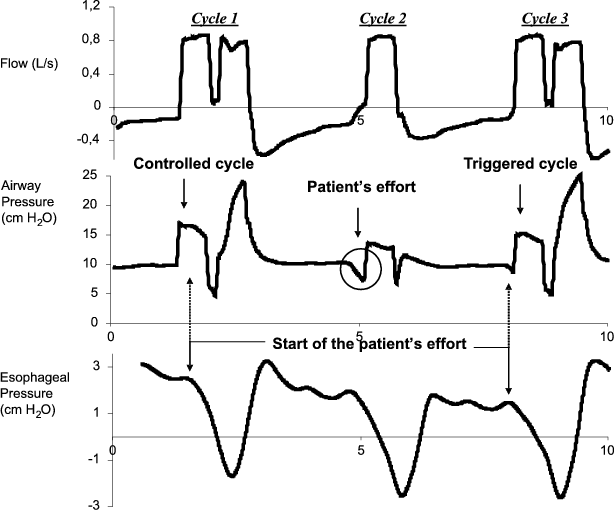Sir: We are grateful to C.W. Chen for his interesting correspondence concerning double triggering during assisted mechanical ventilation. Indeed, double triggering may be relatively frequent during assisted ventilation but has been poorly investigated [1]. We reported that 8% of the patients exhibited frequent double triggering during assisted mechanical ventilation [2]. Double triggering was observed mainly with assist-control ventilation (ACV) in the presence of a short ventilator insufflation time. A short inspiratory time during ACV may explain a higher frequency of double triggering than during pressure support ventilation (PSV). Indeed, ventilator insufflation time tends to be longer than the patient's neural inspiratory time during PSV [3], whereas it is preset during ACV. Patients with frequent double triggering events in our series had more profound hypoxemia than patients without this asynchrony, and higher peak inspiratory pressures. Our interpretation was that double triggering was associated with greater severity of lung injury, and probably with a greater drive to breathe as indicated by a higher respiratory rate [2]. We interpreted double triggering as two consecutive cycles triggered by the same effort in case of a high ventilatory demand, with the patient's effort continuing after the end of the first ventilator insufflation [1]. We could not, however, analyze very accurately the beginning, end, and magnitude of the patient's effort since we used only flow and airway pressure signals, and not esophageal or transdiaphragmatic pressure.
C.W. Chen suggests that the first cycle could be controlled or autotriggered, and not patient triggered (Fig. 1). Our patients were evaluated as soon as they triggered all ventilator breaths, and, different from his patient, the backup rate in ACV was set at its minimal value (3–5 breaths per minute) during the recordings. As a result, we think that the presence of a first controlled ventilator cycle is very unlikely; however, auto-triggering is difficult to detect on ventilator tracings (i.e., flow and airway traces), and we agree that this asynchrony may have been underestimated in our study. A sudden or persistently high respiratory rate, leading to increased alveolar ventilation and respiratory alkalosis, may indicate auto-triggering [4]. A lack of airway pressure drop at the beginning of the cycle is also suggestive of auto-cycling, but the difference with a true triggered breath may be quite subtle in cases of flow triggering. Auto-cycling can cause discomfort by inducing an abrupt airway-pressure increase during ACV. The high respiratory rate and peak pressure reported in our patients exhibiting frequent double triggering could have been favored by frequent auto-triggering; however, this was not associated with hypocapnia and high pressures were explained mainly by high positive end-expiratory pressure values (PEEP). Moreover, the low PaO2/FiO2 ratio (< 200 mmHg) associated with high PEEP suggested a greater severity of lung disease.
Flow (top), airway pressure (middle), and esophageal pressure (bottom) tracings show double triggering defined as two consecutive ventilator cycles separated by a very short, or no, expiratory time. Cycle 1 is a double triggering, including a first controlled breath and a second patient-triggered breath. Indeed, the patient's effort happens after the beginning of the first controlled insufflation. The patient's effort is not completed at the end of this first controlled breath, triggering a second ventilator breath. Peak airway pressure of the second ventilator cycle increases, since a second consecutive tidal volume is delivered without expiration. Cycle 2 illustrates the patient's effort detected using the drop of the airway pressure signal at the initiation of the ventilator cycle. Cycle 3 is a double triggering, corresponding to one patient's effort triggering two ventilator cycles; however, the airway pressure drop at the initiation of the cycle is difficult to detect, due to a sensitive threshold of flow triggering
Although esophageal measurement remains the reference method, decreasing the backup rate at a minimal value in order to eliminate controlled cycles and decreasing the inspiratory trigger sensitivity is a clinical method that can be used to rule out auto-cycling, we did not use it to avoid interferences with clinical settings.
References
Tokioka H, Tanaka T, Ishizu T, Fukushima T, Iwaki T, Nakamura Y, Kosogabe Y (2001) The effect of breath termination criterion on breathing patterns and the work of breathing during pressure support ventilation. Anesth Analg 92:161–165
Thille AW, Rodriguez P, Cabello B, Lellouche F, Brochard L (2006) Patient-ventilator asynchrony during assisted mechanical ventilation. Intensive Care Med 32:1515–1522
Beck J, Gottfried SB, Navalesi P, Skrobik Y, Comtois N, Rossini M, Sinderby C (2001) Electrical activity of the diaphragm during pressure support ventilation in acute respiratory failure. Am J Respir Crit Care Med 164:419–424
Imanaka H, Nishimura M, Takeuchi M, Kimball WR, Yahagi N, Kumon K (2000) Autotriggering caused by cardiogenic oscillation during flow-triggered mechanical ventilation. Crit Care Med 28:402–407
Author information
Authors and Affiliations
Corresponding author
Additional information
This reply refers to the comment available at: http://dx.doi.org/10.1007/s00134-007-0548-8
Rights and permissions
About this article
Cite this article
Thille, A.W., Brochard, L. Double triggering during assisted mechanical ventilation: Is it a controlled, auto-triggered or patient-triggered cycle? Reply to C.-W. Chen. Intensive Care Med 33, 744–745 (2007). https://doi.org/10.1007/s00134-007-0549-7
Accepted:
Published:
Issue Date:
DOI: https://doi.org/10.1007/s00134-007-0549-7


